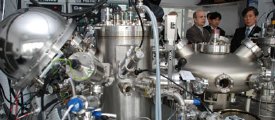Nov 17 2010
The research on materials' surface layers with spectroscopic methods, extremely important for nanotechnology, material engineering, microelectronics and many other areas, requires knowledge of certain physical parameters that are available in the databases distributed by the US National Institute of Standards and Technology (NIST). Used by the researchers worldwide, several of these databases are being developed by Prof. Aleksander Jab³oñski from the Institute of Physical Chemistry of the Polish Academy of Sciences.
Superficial layers of materials, no thicker than several atomic layers, play a key role in many important areas of science and technology, including microelectronics, catalysis or corrosion science. These surface layers are nowadays being studied with different surface sensitive techniques, in particular with electron spectroscopies. Quantitative surface analysis by spectroscopic methods requires, however, taking into consideration certain parameters that are available in the databases distributed by the US National Institute of Standards and Technology (NIST) in Washington. Several of these databases are being developed by Prof. Aleksander Jab³oñski from the Institute of Physical Chemistry of the Polish Academy of Sciences. The coming release of the latest of these databases coincides with honouring of Prof. Jab³oñski's achievements with the Maria Sk³odowska-Curie Scientific Award that is awarded by the Polish Academy of Sciences.

The surface of materials determines the way they interact with the environment. The presence of impurities can, however, change the surface in a hardly predictable manner. "Even when a material contains alien molecules on a few parts per million level, they can migrate to the surface and cover the whole sample. Surface properties of such a substance are then different than those of the material's interior," says Prof. Jab³oñski, stressing that the knowledge on actual physical and chemical properties of materials' surfaces is of paramount importance to industries employing the most recent accomplishments of material engineering, microelectronics and various nanotechnologies.
Surface studies employ usually two research methods: photoelectron spectroscopy and Auger electron spectroscopy. In the former, the surface of the sample is irradiated with X-rays and the electrons ejected by photons from surface layers are recorded. In the latter, the material is bombarded with a monoenergetic electron beam, and the energies of electrons emitted due to intra-atomic radiationless transitions (i.e., transitions not accompanied by photon emission) are recorded. As only the electrons ejected from atoms close to the surface have a chance to leave the sample without energy loss, both methods "see" only a few most external atomic layers of the material.
The photoelectron spectroscopy allows to analyze the valence and the chemical form of elements, as well as the distribution of chemical compounds on the material surface, including non-conductors such as substances of biological origin, ceramics or plastics. An electron beam can be focused easier than the x-rays and therefore the Auger electron spectroscopy allows for a better resolution of the element distribution on the surface, approaching in the most recent instruments 10 nanometres.
Accurate analyses by surface sensitive spectroscopies imply necessarily a development of a reliable theory of electron transport in surface region of condensed matter. The mathematical formalism describing the phenomenon is founded on certain parameters that allow a quantitative surface analysis. Extension of theory accomplished by Prof. Jab³oñski and his proposals of new parameters resulted in a development of comprehensive databases making life easier for electron spectroscopy users. These compilations - containing parameters such as electron scattering cross sections, mean free paths of electrons and electron attenuation lengths - attracted interest of the US National Institute of Standards and Technology that subsequently started to distribute them. As a result, in years 2001-2010 more than 2000 software packages containing databases developed in the Institute of Physical Chemistry of the PAS have been distributed. These databases are commonly used by researchers worldwide. Recently, Prof. Jab³oñski has completed tests of another database, SRD 154, which includes so called modified backscattering factors. The database is scheduled for distribution soon by NIST.
For his work on how to increase the accuracy of surface analyses using spectroscopic techniques, including the preparation of databases for the NIST, Prof. Jab³oñski has been just awarded with the prestigious Maria Sk³odowska-Curie Scientific Award. The award is awarded annually by the Division III Mathematical, Physical and Chemical Sciences of the Polish Academy of Sciences, alternatively in physics and in chemistry. The award is presented to Polish scientists, non-members of the PAS, whose outstanding and creative work particularly contributed to the development of science. A formal award presentation to Prof. Jab³oñski is scheduled to take place in the coming days.